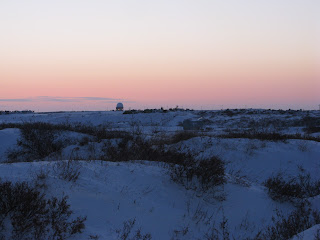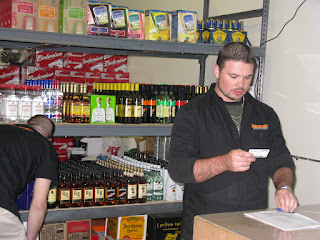 |
| Tall drifts are fun for the kids on cold arctic days. |
Late January and February are popular travel times out of
Kotzebue. Seeking warmer climates, residents leave this village above the Arctic Circle for a weekend, weeks or even a month. Rick and I joined those many travelers the first weekend in February. As it turned out, the weather was warmer in this Eskimo village than in
Anchorage and
Girdwood. Go figure.
During this time of year, the temperatures dip so far below freezing that it can have deleterious effects on the body. The cold arctic wind blows during the day and howls at night. Breathing such cold air can effect a person's lungs. Faces unprotected display a ruddy color or scarring from previous rounds of frostbite.
Face masks, hooded parkies, ski pants, arctic bunny boots or
Sorel glacier boots, along with heavily insulated gloves are a must for being outside. Recently I found and purchased a pair of insulated ski pants that would keep the arctic chill off. This is no easy task when temperatures can dip as low as -40 with or without the wind chill. Winter colds and flu runs through families and drives up absenteeism at the workplace. This kind of weather drives people into their homes or Outside.
The sun comes out to greet this Eskimo village earlier each day. We have been gaining seven minutes of daylight since the winter solstice December 22. As of today, there are 7.7 hours between sunrise and sunset. Scattered clouds bring the hope of warmer temperatures as the U.S. Weather Service is predicting snow early next week. We feel blessed to have the sun back. After its lazy showings in December, the sun rises higher in this polar sky.
So to help us endure the affects of such extreme weather, we travel either on business or for pleasure. For Rick and I, it was a combination of both when we stepped off the plane at
Ted Stevens International Airport in Anchorage, Alaska.
We left Kotzebue last Thursday, the Alaskan-raised man flew out on Alaska Airlines on the afternoon flight 152 and I on 153. Barely making it on the terminal, airline staff were close to sealing the door out to the tarmac. Rushing through check-in, Homeland Security quickly passed my computer tote and other belongings through the x-ray machine prior to walking out to the tarmac to board the plane. Snow was gently falling outside. I drew a few short breaths before entering the 737 combie.
The flight to
Nome was turbulent. The plane was full of passengers but just one rolling pallet of cargo. During the longer flight to Anchorage, the turbulence was severe enough for the crew to cancel in-flight service after attempting to find some airspace with no bumps. The plane landed at the Ted Stevens International Airport at 10:30pm very close to on-time.
Rick met me on the other side of security. Wheeling my red leather bag out to the vehicle, he drove to
Humpy's, a renowned Anchorage pub and seafood place, for a late-night dinner. Darkened lighting, voices, and music enveloped us as we walked through the glass doors. We began blinking our eyelids at the changed conditions. Toto, we're not in Kansas anymore. We sat at a tall table listening to the local band
Woodrow while experiencing the culture shock civilization had caused.
Friday was a workday. Rick attended a couple of meetings and I went into our corporate headquarters to meet with our grant writers and work on some projects. Reconnecting with my co-workers is always a treat. During the quiet mornings and early afternoons at the clubhouse, they are a lifeline to me via mostly email. They also enjoy reconnecting as they rarely see their managers who live in mostly rural areas of Alaska. I come with stories of life in the bush. They offer ways to make work easier and how to tap into more resources for the region.
Eating out is something we look forward to on trips out of Kotzebue. We are privy to a wide variety of foods in Anchorage or Outside. We ate lunch at the Middle Way restaurant where they serve foods made with organic produce, whole grains, and light sauces. My heart was panging as I thought of my friend Rosemary, the rest of the editorial staff and the publishers at
Northwest Magazines sitting down to potluck lunches on Tuesdays at their head office in Florence, Oregon. Other meals out included dinner at the Alaskan landmark
Club Paris, breakfast at Cafe Amsterdam, and a lunch at Red Robin.
 |
| Driving the Seward Highway along Turnagain Arm. |
Since the purpose of this trip included relaxation time, we drove down to Girdwood. This hip ski town is located off the Seward Highway between Anchorage and Whittier. Driving on the
Alaska Highway System to another city is somewhat discombobulating.
Kotzebue, as well as most rural locations, is off the road system. Kotzebue is located on the Baldwin Peninsula 33 miles above the Arctic Circle. The village is only accessible by plane or barge. The closest hub city of Nome is available by plane, or by snow machine or dog sled during the winter.
At the
Alyeska Resort, we had scheduled massages at this high-end skiing mecca. Upon our arrival on their circular driveway, we were greeted by a young man who valet-parked the Camry. The lobby of the resort is spacious and warm colors and stone textures gives the place a soothing feel. Their grand staircase led to a large open area on the second floor that contained a lounge with a view up the mountain, two gift shops and the spa. We opened the opaque glass doors and began to melt into the serene vibe of the place.
After receiving some hot tea and completing their questionnaire, we changed into the luxurious terry cloth robes and waited in silence with those who were either waiting for their appointments or attempting to extend their treatment by hanging around in comfortable chairs drinking lots of water or herbal tea. Ciri, a Girdie Girl, gave me a 50 minute, deep tissue massage while Rick received a relaxation massage.
Fully relaxed we drove the short distance off the hill to the
Chair 5 Restaurant for a late lunch before heading back to Anchorage. This cool, rustic eatery is known for their pizza but they also serve very good burgers, sandwiches, salads, and soups. The restaurant is a local hangout after a day on the mountain. I was impressed by their taco salad, which is a feast of black beans, yummy salsa, tasty chicken and salad fixings layered on a bed of tortilla chips. Rick had the halibut and chips. Both were outstanding.
 |
| Sunset along Seward Highway outside of Girdwood. |
We drove back to Anchorage in the late afternoon, fully relaxed and rejuvenated. The cold Alaska air filled the compartment when I rolled down the window to take photos of the snow covered mountains along the Turnagain Arm. Temperatures had dipped down into the teens while the tide rushed out exposing frozen ice on the bottom of this shallow tidal water.
We ate at the Tap Root for dinner and listened to local musicians rocking the packed house. The first act involved a acoustic guitar musician from Seward while the cover band was from
Spenard, a former 'red light district' that had been incorporated into Anchorage. They were called
Last Train. Awesome guitar playing, drums and three very good vocalists provided the impetus for people to get out of their chairs to dance on the parquet floor until after midnight.
On Sunday we awoke early for we had many errands to run. Travelers in from the villages normally make a grocery run before returning to their homes in remote areas where food is expensive and not very fresh. After finishing up the shopping, getting a haircut, purchasing vinyl fabric for an Eskimo drum-making project, and eating lunch at the Red Robin, Rick drove our silver vehicle to the airport. After checking in, he drove the Camry back to our friends' cottage, plugged the heated battery blanket into the box, and returned to the airport.
I did a little shopping and then called my dad for our weekly visit. During the call, two young girls sat down next to me and drew on their electronic sketch pads. One of the girls had spent an afternoon at the Kotzebue club. I drew a sketch of a woman with long black hair wearing an Eskimo parkie. Her sister drew the same with good skill. We enjoyed our time together before they returned to the gate where their mother was caring for their toddler brother.
Our weekend away was coming to a close. Soon we would walk down the tarmac and join the other passengers heading home to Kotzebue and Nome. Relaxed and well rested back to the Arctic where the temperatures were around 20 degrees and a light snow was falling. We headed back to temperatures that would soon return to well below zero and we were ready.
Spring is coming to this Far North village. With more daylight and warmer temperatures, soon the winter would be a vague memory. But until that time, we will stay warm in our apartment and venture out when necessary to handle day to day living in Kotzebue.









































